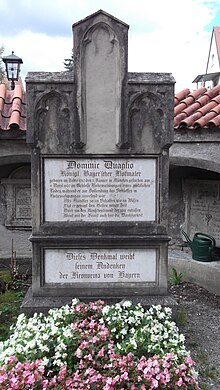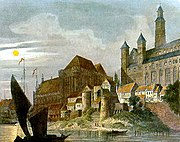Domenico Quaglio

Johann Dominicus Quaglio (born January 1, 1787 in Munich , † April 9, 1837 in Hohenschwangau Castle near Füssen ), known as Domenico Quaglio [II] , was one of the most important architectural painters of the German Romantic era , theater painter , lithographer and etcher .
Origin and family
The extensive Italian-German artist family Quaglio , from which a number of well-known painters and architects emerged from the 17th to the 20th century, originally came from Laino in the Val d'Intelvi ( Italy ) between Lake Lugano and Lake Como and was with Elector Karl Theodor moved from Mannheim to Munich. Domenico Quaglio was born as one of eleven children of the painter and architect Giuseppe Quaglio . His brother is the landscape and genre painter Lorenzo Quaglio II , who became known as a portrayal of Upper Bavarian farmers. On January 28, 1819, Domenico Quaglio married Josepha Sedlmayr, whose marriage resulted in four daughters and three sons. The eldest daughter Josepha married the animal painter Benno Adam in 1834 . The second daughter Agnes (1821-1854), married to Josef Benedikt Buchner, he trained himself to be a landscape and figure painter in Munich. She is the ancestor of the Düsseldorf architect Hans Junghanns .
life and work
Domenico Quaglio was trained as a copperplate engraver and lithographer first by his father Giuseppe and then at the Munich Art Academy under Carl Ernst Christoph Hess and Johann Michael Mettenleiter . He remained friends with his fellow students Peter von Hess and Ludwig Emil Grimm after his studies. From 1803 he was a decorative painter at the court theater in Munich and from 1808 to 1814 he was a special court theater painter for architectural sceneries, when he also designed the stage decorations.
Domenico Quaglio is the founder of the Munich architectural image and the most important representative of romantic vedute painting . He undertook extensive trips through Germany, to the Rhine, to the Netherlands, France, Italy and Switzerland, from which he brought back extensive drawings of medieval churches, palaces, castles, ruins, town halls, etc. He was one of the first to use the new technique of lithography and he exhausted its artistic means to reproduce medieval buildings in prints. His leaves are among the most important incunabula of lithography. After 1819 he devoted himself particularly to oil painting .
In keeping with his romantic disposition, he was particularly fond of Gothic buildings . The most important Gothic Dome has held the painter in the facts in its state: Regensburg Cathedral , Cologne Cathedral , Frankfurt Cathedral , Strasbourg Cathedral , Freiburg Cathedral , Minster , Cathedral of Reims , Rouen Cathedral , Cathedral of Orvieto , etc. In addition, he created a number of views other Gothic buildings and medieval cities, such as B. Hildesheim . An important series of paintings deals with the buildings, squares and streets of Munich before the radical redesign by King Ludwig I and which the King himself commissioned.
Quaglio raised architectural painting back to artistic importance. He did not paint artistically freely, but with the realism of the vedute , which is why his pictures are often documents of architectural history. But although his pictures always have a documentary character, the scenes, as in Canaletto's vedutas, are enlivened by the choice of image detail as well as the varied play of light and shadow, as well as graceful and moving (also interesting in terms of costume history) figures. This is why Domenico Quaglio is sometimes referred to as the Canaletto of the North . He was appointed Bavarian court painter and later also accepted as a member of the academies in Munich and Berlin. Together with Peter von Hess , Friedrich von Gärtner and Joseph Karl Stieler , he founded the Münchner Kunstverein in 1823, the first in Germany.
In 1832, Crown Prince Maximilian commissioned Quaglio to rebuild and decorate Hohenschwangau Castle . According to his designs, the medieval castle ruins were converted into a picturesque castle in the neo-Gothic style by 1837 . Significantly, the king had given Quaglio the overall management of the building and only assigned the architect Friedrich Ziebland to him. During this time he was almost completely alone with the work and without experience in managing what was also quite a large building, Domenico Quaglio collapsed on the construction site shortly before the completion of the castle and died shortly afterwards at the age of 50. After his death, Moritz von Schwind took care of the painting of the rooms planned by Quaglio .
His grave is in the old St. Sebastian cemetery in Füssen, the tombstone is still preserved and bears the following lines: "This monument dedicated to his memory the Crown Prince of Bavaria ".
Braunschweig: " Old Town Market from the East" from 1834.
Works (literature)
Domenico Quaglio published some folders of his engravings:
- Collection of strange buildings from the Middle Ages in Germany . Velten, Karlsruhe 1810 (2 vol.)
- Views of strange buildings in Munich . Hirmer, Munich 1811 (2 vol.)
- Monuments of the architecture of the Middle Ages in Bavaria . Hirmer, Munich 1816
literature
- Peter Prange: Quaglio, Domenico II. In: New German Biography (NDB). Volume 21, Duncker & Humblot, Berlin 2003, ISBN 3-428-11202-4 , p. 31 f. ( Digitized version ).
- Brigitte Trost (Mudrak-Trost): Domenico Quaglio 1787-1837. Monograph and catalog raisonné . Prestel, Munich 1973, ISBN 3-7913-0346-5 (standard work on Domenico Quaglio)
Web links
- Literature by and about Domenico Quaglio in the catalog of the German National Library
- Works by Domenico Quaglio at Zeno.org .
supporting documents
- ↑ Domenico Quaglio on deutsche-biographie.de (accessed on January 4, 2017).
- ↑ Ursula Stevens: Domenico Quaglio. In: tessinerkuenstler-ineuropa.ch. 2016, accessed November 21, 2016 .
| personal data | |
|---|---|
| SURNAME | Quaglio, Domenico |
| ALTERNATIVE NAMES | Quaglio, Johann Dominicus |
| BRIEF DESCRIPTION | Architectural painter of the German Romanticism |
| DATE OF BIRTH | January 1, 1787 |
| PLACE OF BIRTH | Munich , Germany |
| DATE OF DEATH | April 9, 1837 |
| Place of death | Hohenschwangau Castle , Hohenschwangau , Germany |








